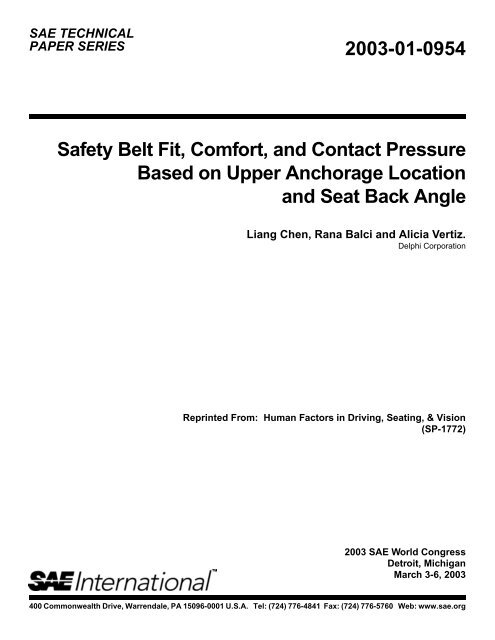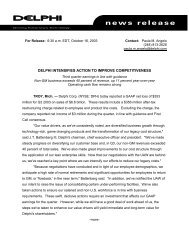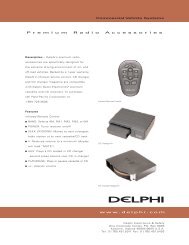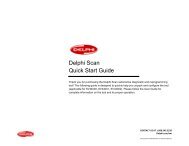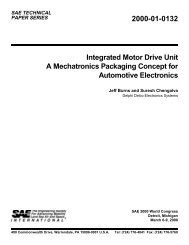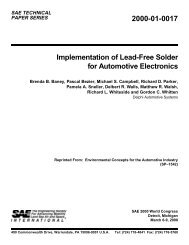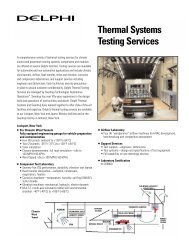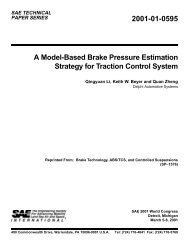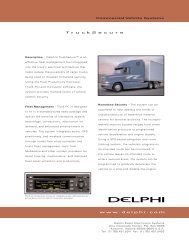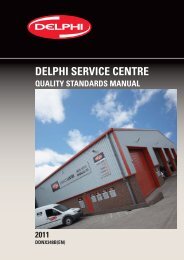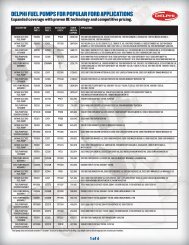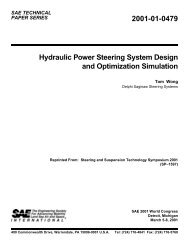2003-01-0954 Safety Belt Fit, Comfort, and Contact ... - Delphi
2003-01-0954 Safety Belt Fit, Comfort, and Contact ... - Delphi
2003-01-0954 Safety Belt Fit, Comfort, and Contact ... - Delphi
You also want an ePaper? Increase the reach of your titles
YUMPU automatically turns print PDFs into web optimized ePapers that Google loves.
SAE TECHNICAL<br />
PAPER SERIES <strong>2003</strong>-<strong>01</strong>-<strong>0954</strong><br />
<strong>Safety</strong> <strong>Belt</strong> <strong>Fit</strong>, <strong>Comfort</strong>, <strong>and</strong> <strong>Contact</strong> Pressure<br />
Based on Upper Anchorage Location<br />
<strong>and</strong> Seat Back Angle<br />
Liang Chen, Rana Balci <strong>and</strong> Alicia Vertiz.<br />
<strong>Delphi</strong> Corporation<br />
Reprinted From: Human Factors in Driving, Seating, & Vision<br />
(SP-1772)<br />
<strong>2003</strong> SAE World Congress<br />
Detroit, Michigan<br />
March 3-6, <strong>2003</strong><br />
400 Commonwealth Drive, Warrendale, PA 15096-00<strong>01</strong> U.S.A. Tel: (724) 776-4841 Fax: (724) 776-5760 Web: www.sae.org
All rights reserved. No part of this publication may be reproduced, stored in a retrieval system, or<br />
transmitted, in any form or by any means, electronic, mechanical, photocopying, recording, or otherwise,<br />
without the prior written permission of SAE.<br />
For permission <strong>and</strong> licensing requests contact:<br />
SAE Permissions<br />
400 Commonwealth Drive<br />
Warrendale, PA 15096-00<strong>01</strong>-USA<br />
Email: permissions@sae.org<br />
Fax: 724-772-4028<br />
Tel: 724-772-4891<br />
For multiple print copies contact:<br />
SAE Customer Service<br />
Tel: 877-606-7323 (inside USA <strong>and</strong> Canada)<br />
Tel: 724-776-4970 (outside USA)<br />
Fax: 724-776-1615<br />
Email: CustomerService@sae.org<br />
ISSN <strong>01</strong>48-7191<br />
Copyright © <strong>2003</strong> SAE International<br />
Positions <strong>and</strong> opinions advanced in this paper are those of the author(s) <strong>and</strong> not necessarily those of SAE.<br />
The author is solely responsible for the content of the paper. A process is available by which discussions<br />
will be printed with the paper if it is published in SAE Transactions.<br />
Persons wishing to submit papers to be considered for presentation or publication by SAE should send the<br />
manuscript or a 300 word abstract of a proposed manuscript to: Secretary, Engineering Meetings Board, SAE.<br />
Printed in USA
<strong>2003</strong>-<strong>01</strong>-<strong>0954</strong><br />
<strong>Safety</strong> <strong>Belt</strong> <strong>Fit</strong>, <strong>Comfort</strong>, <strong>and</strong> <strong>Contact</strong> Pressure Based on Upper<br />
Anchorage Location <strong>and</strong> Seat Back Angle<br />
Copyright © <strong>2003</strong> SAE International<br />
ABSTRACT<br />
A seat belt usability study was conducted to investigate<br />
factors associated with seat belt comfort <strong>and</strong> convenience<br />
related to shoulder belt contact pressure, shoulder belt fit,<br />
<strong>and</strong> seat belt upper anchorage location.<br />
Two major objectives were addressed in this study: (1)<br />
Determine the shift in the contact pressure while<br />
changing the seat back angle <strong>and</strong> seat belt attachment<br />
points / B-pillar location by utilizing a body pressure<br />
measurement system; (2) Identify how seat belt contact<br />
pressure <strong>and</strong> fit affect users’ subjective feeling of<br />
comfort.<br />
Results from the statistical analysis shows that the seat<br />
belt contact pressure increases when the D-ring moves<br />
away from the driver in the fore-aft direction (X-axis)<br />
whereas height adjustment of the D-ring (Z-axis) is not<br />
statistically significant in terms of pressure distribution.<br />
Seat back angle, fore-aft (X-axis) <strong>and</strong> lateral (Y-axis)<br />
positions of the D-ring, <strong>and</strong> seat belt sub-segments are<br />
found to be statistically significant in the analysis of<br />
subjective comfort rating for contact pressure, which<br />
comply with the results obtained from the statistical<br />
analysis of mean contact pressure <strong>and</strong> distribution. In the<br />
analysis of subjective comfort rating on seat belt<br />
fit/routing, height adjustment of the D-ring is statistically<br />
significant. This indicates that the height adjustment for<br />
seat belt upper anchorage point is essential to achieve a<br />
better seat belt fit, help reduce the risk of seat belt<br />
rubbing the neck or slipping off the occupant’s shoulder,<br />
given that it cannot improve the contact comfort by<br />
reducing the contact pressure.<br />
INTRODUCTION<br />
The protection provided to vehicle occupants by the<br />
three-point seat belt is no longer disputed over the world.<br />
Vehicular seat belts were originally developed to help<br />
prevent serious injury to a restrained occupant. Its<br />
function is to decelerate the occupant in the vehicle by<br />
distributing the forces of collision across the body of the<br />
Liang Chen, Rana Balci <strong>and</strong> Alicia Vertiz<br />
<strong>Delphi</strong> Corporation<br />
occupant <strong>and</strong> by restraining the occupant inside the<br />
vehicle during a collision or rollover event. Therefore,<br />
increasing the usage rate of the seat belt is a primary<br />
goal of all national transport safety policies in motorized<br />
countries. Figure 1 shows the seat belt use rates in the<br />
U.S. between 1998 <strong>and</strong> 20<strong>01</strong>. The average seat belt use<br />
rate in the year 20<strong>01</strong> reached its all-time high, which is<br />
73%.<br />
Year<br />
20<strong>01</strong><br />
2000<br />
1999<br />
1998<br />
71%<br />
67%<br />
73%<br />
69%<br />
0% 30% 60% 90%<br />
Use Rate (%)<br />
Figure 1. Seat <strong>Belt</strong> Use Rate in U.S. (Source: National<br />
Highway Traffic <strong>Safety</strong> Administration, 2002)<br />
To achieve high levels of usage rate, points of concern<br />
still are effectiveness, comfort, <strong>and</strong> convenience, which<br />
depend largely on the extent of the geometric design of<br />
seat belts matching the occupant’s anatomical<br />
characteristics. This study focuses on the comfort <strong>and</strong><br />
convenience aspects of safety belts from human factors<br />
point of view.<br />
A number of studies have highlighted potential issues<br />
related to the seat belt comfort <strong>and</strong> convenience<br />
(Woodson, et. al., 1980, <strong>and</strong> Wilcoxon, 1998). A<br />
questionnaire administered by <strong>Delphi</strong> (Balci, et al., 20<strong>01</strong>)<br />
concludes that a primary reason many people give for not<br />
wearing a seat belt is that it is inconvenient to be fastened<br />
<strong>and</strong> unfastened <strong>and</strong> uncomfortable to wear, especially in<br />
some specific stature groups, e.g., small females <strong>and</strong><br />
large males. Therefore, a seat belt usability study was<br />
conducted to investigate the factors associated with seat<br />
belt comfort <strong>and</strong> convenience with respect to shoulder<br />
belt contact pressure, shoulder belt fit, <strong>and</strong> seat belt<br />
upper anchorage location.
One objective of the study is to determine the shift in the<br />
contact pressure while changing the seat back angle <strong>and</strong><br />
the location of the seat belt upper attachment points (Dring)<br />
by utilizing a body pressure measurement system.<br />
Another is to identify how seat belt contact pressure <strong>and</strong><br />
fit affect users’ subjective feelings of comfort.<br />
METHOD<br />
Each participant was tested with 54 experimental<br />
scenarios to investigate the seat belt pressure levels, seat<br />
belt fit, <strong>and</strong> subjective comfort ratings resulting from<br />
various geometric configurations of the D-ring, seat back<br />
angles, <strong>and</strong> different anthropometric dimensions.<br />
SET-UP<br />
The set-up consists of a universal seating buck to<br />
simulate a passenger car interior package. The threepoint<br />
belt system was configured to represent an<br />
adjustable "D"-ring anchor with three different levels of<br />
seat back angle. Extra webbing was provided to allow<br />
measuring the seat belt comfort <strong>and</strong> fit for extreme<br />
geometric configurations. In addition, the seat was in a<br />
fixed position during the entire test.<br />
MEASUREMENTS<br />
Tekscan ISCAN V4.23 pressure measurement system<br />
was utilized to sample the pressure distribution on the<br />
seat belt. For convenience in describing the pressure<br />
distribution patterns, the pressure sensor with a resolution<br />
of 44 x 52 is virtually divided into 8 even segments.<br />
Segment number 1 to 8 indicate the relative seat belt<br />
portion from top of the shoulder to the buckle location<br />
(Figure 2). A Metrecom 3D Digitizer was also utilized to<br />
collect the participants’ 17 st<strong>and</strong>ard anthropometric<br />
measurements, e.g., st<strong>and</strong>ing height, seating height,<br />
shoulder width, etc.<br />
8: ASIS/Buckle<br />
4: Sternum<br />
6: Abdomen<br />
1: Top of Shoulder<br />
3: Upper Chest<br />
Figure 2. Seat <strong>Belt</strong> Segments Definition<br />
2<br />
TEST PARTICIPANTS<br />
A total of 15 volunteers, including 11 males <strong>and</strong> 4<br />
females, participated the test. Their height <strong>and</strong> Body<br />
Mass Index (BMI) data are summarized in Table 1.<br />
Table 1. Anthropometric Data for Test Subjects (N=15)<br />
Height (inch) BMI<br />
MEAN 68.48 25<br />
STDEV 3.20 6.50<br />
MAX 72.30 43<br />
MIN 61.70 17<br />
Table 2 lists the height <strong>and</strong> BMI in three categories:<br />
• 4 short stature females (66%-ile)<br />
Table 2. Grouping information for Test Participants<br />
BMI (Body<br />
Mass Index)<br />
Table 3. Three Percentile Categories of Participants<br />
Female Male<br />
Percentile Height (mm) Height (mm)<br />
1761<br />
Within-Subjects Factors:<br />
• B-pillar Fore-aft adjustment (3 locations/levels)<br />
0. foremost<br />
1. middle<br />
2. rearmost<br />
• B-Pillar inboard-outboard adjustment (3<br />
locations/levels)<br />
0. Inside<br />
1. Middle<br />
2. Outside<br />
• B-Pillar up-down adjustment (2 locations/levels)<br />
0. Upper<br />
1. Lower<br />
• Seat back angle (3 levels)<br />
0 degree<br />
10 degree<br />
20 degree<br />
Response Variables:<br />
1. The contact pressure <strong>and</strong> its distribution on the<br />
seat belt<br />
2. Subjective comfort ratings on seat belt pressure<br />
3. Subjective comfort ratings on seat belt fit/routing<br />
With the above experimental design, each participant took<br />
a total of 54 tests including different scenarios <strong>and</strong> the<br />
three response variables were recorded in each test.<br />
RESULTS<br />
OBJECTIVE MEASUREMENTS OF CONTACT<br />
PRESSURE<br />
ANOVA analysis (see Appendix ANOVA Table 4) shows<br />
that height adjustment of the D-ring (Z-axis) is not<br />
statistically significant in terms of pressure distribution<br />
(p=0.325). This may indicate that the D-ring location in<br />
up-<strong>and</strong>-down direction has a little impact on the seat belt<br />
contact pressure. Mean pressure distribution as a<br />
function of seat back angle, D-ring locations in fore-aft<br />
(X-axis) <strong>and</strong> lateral (Y-axis) directions were shown in<br />
Figures 3, 4 <strong>and</strong> 5. A very similar trend of pressure<br />
distribution shown in these figures indicate that seat belt<br />
pressure has peak values at chest <strong>and</strong> abdomen<br />
(segments # 3 <strong>and</strong> # 6) while the lowest mean value<br />
occurred at segments # 2 <strong>and</strong> # 5.<br />
3<br />
Figure 6 represents the mean pressure distribution as a<br />
function of the D-ring location in both fore-aft <strong>and</strong><br />
inboard-outboard directions. First, it is obvious that<br />
contact pressure is lower when D-ring moves towards the<br />
occupant in fore-aft direction. Furthermore, in terms of<br />
inboard-outboard adjustments, it is observed that an<br />
optimal location exists that results in a relatively low<br />
pressure value. Moving the D-ring either inboard or<br />
outboard from this location would increase the seat belt<br />
contact pressure on the occupant’s upper torso. In<br />
addition, It was found that the lowest mean pressure<br />
occurred when the location of the D-ring was at the most<br />
forward position on the fore-aft axis (close to shoulder)<br />
<strong>and</strong> at the middle position of the lateral Y-axis.<br />
Mean Pressure (g/cm2)<br />
.12<br />
.10<br />
.08<br />
.06<br />
.04<br />
.02<br />
1.00<br />
2.00<br />
3.00<br />
4.00<br />
5.00<br />
Seat <strong>Belt</strong> Segments<br />
6.00<br />
7.00<br />
8.00<br />
Seat Back Angle<br />
0 degree<br />
10 degree<br />
20 degree<br />
Figure 3. Mean Pressure Distribution as a Function of<br />
Seat Back Angle<br />
Mean Pressure (g/cm2)<br />
.10<br />
.09<br />
.08<br />
.07<br />
.06<br />
.05<br />
.04<br />
.03<br />
.02<br />
1.00<br />
2.00<br />
3.00<br />
4.00<br />
5.00<br />
Seat <strong>Belt</strong> Segments<br />
6.00<br />
7.00<br />
8.00<br />
D-ring in X-axis<br />
Figure 4. Mean Pressure Distribution as a Function of<br />
"D"-ring Location in Fore-Aft Direction<br />
Foremost<br />
Middle<br />
Rearmost
Mean Pressure (g/cm2)<br />
.09<br />
.08<br />
.07<br />
.06<br />
.05<br />
.04<br />
.03<br />
1.00<br />
2.00<br />
3.00<br />
4.00<br />
5.00<br />
Seat <strong>Belt</strong> Segments<br />
6.00<br />
7.00<br />
8.00<br />
D-ring in Y-axis<br />
Inside<br />
Middle<br />
Outside<br />
Figure 5. Mean Pressure Distribution as a Function of<br />
"D"-ring Location in Inboard-Outboard Direction<br />
Mean Pressure (g/cm2)<br />
.08<br />
.07<br />
.06<br />
.05<br />
.04<br />
.03<br />
Inside<br />
Middle<br />
D-ring in Y-axis<br />
Outside<br />
D-ring in X-axis<br />
Foremost<br />
Middle<br />
Rearmost<br />
Figure 6. Mean Pressure Distribution as a Function of<br />
"D"-ring Locations in Both Fore-Aft <strong>and</strong> Inboard-Outboard<br />
Directions.<br />
SUBJECTIVE RATING ON CONTACT PRESSURE AND<br />
SEAT BELT FIT<br />
ANOVA on subjective rating of contact pressure (see<br />
Appendix ANOVA Table 4) shows that the seat back<br />
angle, D-ring location in both fore-aft <strong>and</strong> inboardoutboard<br />
directions are still statistically significant. This<br />
outcome complies with the results from the ANOVA on<br />
objective measurements of contact pressure <strong>and</strong><br />
distribution. Conversely, the D-ring location in height<br />
adjustment is not a significant factor, which means that it<br />
has a little impact on sensed seat belt pressure in terms<br />
of occupant’s subjective feeling. However, in ANOVA on<br />
subjective rating regarding seat belt fit/routing; all of the<br />
4<br />
variables, including seat back angle, D-ring in fore-aft,<br />
lateral, <strong>and</strong> vertical directions, are statistically significant.<br />
This finding indicates that the height adjustment for seat<br />
belt upper attachment point is essential to achieve a better<br />
seat belt fit/routing <strong>and</strong> to help reduce the risk of seat belt<br />
rubbing the neck or slipping off the occupant’s shoulder.<br />
However, it cannot improve the contact comfort by<br />
reducing the contact pressure. Figure 7 displays the<br />
mean value/ trend of occupants’ comfort rating on seat<br />
belt fit with respect to the seat back angle <strong>and</strong> D-ring<br />
location on Z-axis. There is a significant difference in<br />
comfort rating for different levels of D-ring height, which<br />
support the results from ANOVA table (Table 4 in<br />
Appendix).<br />
As a general observation from the experiment, some<br />
participants who were in the low height <strong>and</strong> low BMI<br />
category complained about the seat belt rubbing their<br />
necks. Although it cannot be generalized due to the small<br />
number of participants, a similar complaint was received<br />
from the participants who were at the higher end of the<br />
BMI <strong>and</strong> height scale combination.<br />
Mean Pressure (g/cm2)<br />
2.8<br />
2.6<br />
2.4<br />
2.2<br />
2.0<br />
1.8<br />
0 degree<br />
10 degree<br />
Seat Back Angle<br />
20 degree<br />
D-ring in Z-axis<br />
Figure 7. Subjective Rating on Seat <strong>Belt</strong> <strong>Fit</strong> as a<br />
Function of Seat Back Angle <strong>and</strong> "D"-ring Locations in<br />
Different Height Levels<br />
Note: <strong>Comfort</strong> Rating Scale (1-5)<br />
1: Slipping off the shoulder<br />
3: Just right<br />
5: Rubbing the neck<br />
DISCUSSION<br />
In this study, height <strong>and</strong> BMI data of all participants were<br />
recorded as the between-subject variables. However, the<br />
results of ANOVA with repeated measurements for each<br />
participant show that body height <strong>and</strong> BMI are not<br />
statistically significant. Hypothetically, body height <strong>and</strong><br />
High<br />
Low
BMI should have an impact on the seat belt pressure<br />
because of the changes in the belt geometry, similar to<br />
changing D-ring locations in belt configuration. One<br />
possible reason is that seat belt pressure in normal<br />
driving condition is in a relatively low range that results in<br />
minor discomfort. Although the relative pressure<br />
distribution was analyzed in this test, observation of a<br />
difference in absolute pressure value may have been<br />
missed due to the current setup for different stature<br />
groups. However, the interaction of height <strong>and</strong> BMI is<br />
found to be significant in ANOVA on comfort rating of<br />
seat belt fit/routing. This indicates that body height <strong>and</strong><br />
BMI do have an influence on seat belt fit/ routing due to<br />
the different body statures <strong>and</strong> weights. To better explain<br />
the difference in belt contact pressure <strong>and</strong> subjective<br />
ratings of different stature groups, a further study with<br />
larger sample size, particularly in small <strong>and</strong> large stature<br />
groups, is recommended.<br />
A linear regression analysis was also conducted in each<br />
stature group based on the current sample size <strong>and</strong><br />
quantitative measurements. Relatively low R-Square <strong>and</strong><br />
non-r<strong>and</strong>om residual distribution around zero level<br />
indicates that either there are more unknown factors that<br />
play a role in prediction of seat belt pressure, comfort<br />
rating, <strong>and</strong> seat belt routing or the functions to all<br />
independent variables are not linear. Theoretically, inside<br />
each stature group, there is still a considerable difference<br />
among participants in terms of BMI, upper body shape,<br />
etc. Larger sample size <strong>and</strong> sub-grouping inside each<br />
stature group can be helpful to find out the root cause of<br />
the problem. The effect of gender was also not<br />
considered in this study due to the limited number of<br />
females, especially in small stature group.<br />
CONCLUSION<br />
1. The "D"-Ring location on fore-aft <strong>and</strong> inboardoutboard<br />
directions <strong>and</strong> the seat back angle are<br />
statistically significant on the seat belt pressure.<br />
2. Height adjustment of D-Ring location has no<br />
significant impact on contact pressure, but improve<br />
the comfort of seat belt fit.<br />
3. There is a similar trend of pressure distribution for all<br />
test scenarios: higher mean pressure occurred at<br />
upper chest (segment # 3) <strong>and</strong> abdomen (segment #<br />
6) <strong>and</strong> lower mean pressure occurred at upper<br />
shoulder (segment # 2) <strong>and</strong> sternum (segment # 5)<br />
4. Height <strong>and</strong> BMI of the participants are not statistically<br />
significant in the Repeated Measures ANOVA using<br />
SPSS GLM. Further analysis <strong>and</strong> research work is<br />
needed to investigate the seat belt pressure for<br />
different stature groups.<br />
5. A linear regression analysis on seat belt contact<br />
pressure <strong>and</strong> seat belt fit shows poor prediction<br />
capability possibly due to the low pressure<br />
measurements <strong>and</strong> small sample size.<br />
5<br />
REFERENCES<br />
1. Balci, R., Vertiz, A, <strong>and</strong> Shen, W., 20<strong>01</strong>, “<strong>Comfort</strong><br />
<strong>and</strong> Usability of the Seat <strong>Belt</strong>”, SAE Technical Paper<br />
No. 20<strong>01</strong>-<strong>01</strong>-0051, 20<strong>01</strong>.<br />
2. NHTSA (National Highway Traffic <strong>Safety</strong><br />
Administration), www.nhtsa.gov<br />
3. Wilcoxon, K., "Improving Seat <strong>Belt</strong> <strong>Comfort</strong> on Off-<br />
Highway Vehicles", SAE Technical Paper No.<br />
982058, 1998.<br />
4. Woodson, W.E., Selby, P.H., <strong>and</strong> Coburn, R., 1980,<br />
<strong>Comfort</strong> <strong>and</strong> Convenience: Specifications for <strong>Safety</strong><br />
<strong>Belt</strong>s: Shoulder <strong>Belt</strong> <strong>Fit</strong>, Pressure <strong>and</strong> Pullout Forces,<br />
DOT Report HS-805 597.
APPENDIX<br />
Table 4. ANOVA Table (Tests of Within-Subjects Effects)<br />
Source Dependent Variable Type III Sum of Squares df Mean Square F Sig.<br />
Corrected Model PRESSURE 4.022 a 227 1.772E-02 3.654 .000<br />
COMP 1679.256 b 227 7.398 4.240 .000<br />
COMR 3352.118 c 227 14.767 22.209 .000<br />
Intercept PRESSURE 18.458 1 18.458 3806.214 .000<br />
COMP 15<strong>01</strong>45.195 1 15<strong>01</strong>45.195 86049.<strong>01</strong>3 .000<br />
COMR 36712.928 1 36712.928 55214.661 .000<br />
SEAT BACK PRESSURE .845 2 .423 87.126 .000<br />
ANGLE COMP 837.554 2 418.777 240.003 .000<br />
COMR 94.664 2 47.332 71.186 .000<br />
D_RING PRESSURE .610 2 .305 62.919 .000<br />
X-axis COMP 670.898 2 335.449 192.248 .000<br />
COMR 1080.735 2 540.368 812.689 .000<br />
D_RING PRESSURE 5.423E-02 2 2.712E-02 5.592 .004<br />
Y-axis COMP 27.528 2 13.764 7.888 .000<br />
COMR 1699.751 2 849.875 1278.176 .000<br />
D_RING PRESSURE 4.691E-03 1 4.691E-03 .967 .325<br />
Z-axis COMP 3.129 1 3.129 1.793 .181<br />
COMR 209.952 1 209.952 315.759 .000<br />
BELT PRESSURE 1.140 7 .163 33.576 .000<br />
SEGMENT COMP .000 7 .000 .000 -<br />
COMR .000 7 .000 .000 -<br />
a R Squared = .117 (Adjusted R Squared = .085) on PRESSURE (pressure measurement)<br />
b R Squared = .133 (Adjusted R Squared = .102) on COMP (subjective comfort rating on pressure)<br />
c R Squared = .446 (Adjusted R Squared = .426) on COMR (subjective comfort rating on belt fit/routing)<br />
6


